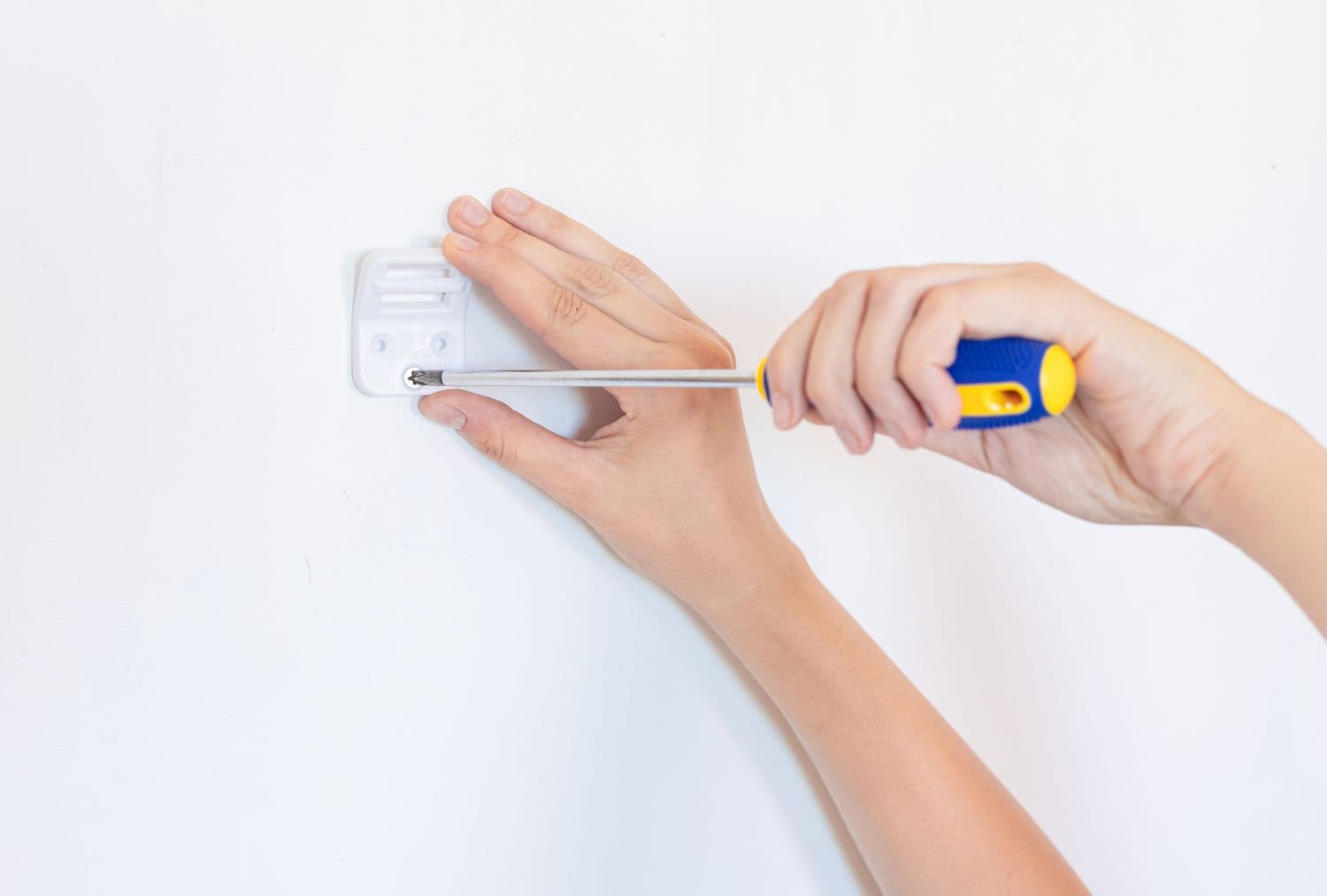How to Anchor Furniture to a Wall? Anchoring furniture refers to the process of securing furniture to the wall or floor to prevent it from tipping over. This is an important safety measure that should not be overlooked, as unsecured furniture can pose a serious risk, especially in households with young children or pets.
Accidents involving falling furniture can result in injuries, and in some cases, even fatalities. By properly anchoring furniture, you can significantly reduce the risk of accidents and create a safer living environment for your family.
The Importance of Anchoring Furniture
Statistics on furniture-related accidents paint a grim picture of the dangers posed by unsecured furniture. According to the Consumer Product Safety Commission (CPSC), an estimated 25,000 children are treated in emergency rooms each year for injuries caused by falling furniture. Tragically, approximately one child dies every two weeks due to furniture tip-over accidents. These statistics highlight the urgent need for anchoring furniture to prevent such accidents.
The risks of not anchoring furniture are significant. Heavy items such as bookshelves, dressers, and televisions can easily tip over if not properly secured. This is especially true if they are top-heavy or if a child attempts to climb on them. When a piece of furniture falls, it can cause serious injuries such as concussions, broken bones, and even suffocation if a child becomes trapped underneath. By taking the time to anchor your furniture, you can greatly reduce the risk of these accidents occurring.
In addition to the obvious safety benefits, there are other advantages to anchoring furniture. By securing your furniture, you can also protect your belongings from damage. When a piece of furniture falls, it can cause significant damage to walls, floors, and other items in its path. By anchoring your furniture, you can prevent this type of damage and save yourself from costly repairs.
Types of Furniture that Require Anchoring
There are several types of furniture that should be anchored to ensure safety. Some examples include bookshelves, dressers, cabinets, televisions, and appliances. These items are often top-heavy and can easily tip over if not properly secured. Additionally, furniture that is frequently accessed or climbed on by children, such as bunk beds or playsets, should also be anchored to prevent accidents.
Certain furniture items require anchoring due to their design or construction. For example, tall bookshelves with open shelves are more prone to tipping over because they have a higher center of gravity. Dressers with drawers that extend outwards can also become unstable if not properly secured. Televisions and appliances should be anchored to prevent them from falling off of stands or countertops.
Tools and Materials Needed for Anchoring Furniture
To properly anchor your furniture, you will need a few tools and materials. Here is a list of what you will need:
1. Stud Finder: A stud finder is a handheld device that helps you locate the wooden studs behind your walls. This is important because you will need to anchor your furniture into the studs for maximum stability.
2. Screws: You will need screws that are long enough to penetrate through the furniture and into the wall or floor. The length of the screws will depend on the thickness of your furniture and the type of wall or floor you are anchoring into.
3. Wall Anchors: Wall anchors are used when there are no studs available to anchor into. They provide additional support by distributing the weight of the furniture across a larger area of the wall.
4. Drill: A drill is necessary for creating pilot holes in the furniture and walls before inserting screws. Make sure to use a drill bit that is slightly smaller than the diameter of the screws you are using.
5. Level: A level is used to ensure that your furniture is straight and level before anchoring it. This will help prevent any wobbling or instability once the furniture is secured.
How to Measure and Mark for Anchoring
Before you begin anchoring your furniture, it is important to measure and mark the correct locations for the screws. Here is a step-by-step guide on how to do this:
1. Measure the height of your furniture: Use a tape measure to determine the height of your furniture. This will help you determine the appropriate height for anchoring.
2. Locate the studs: Use a stud finder to locate the wooden studs behind your walls. Mark the locations of the studs with a pencil.
3. Measure and mark the location for anchoring: Measure and mark the desired height for anchoring on both the furniture and the wall. Make sure to align these marks with the studs you located earlier.
4. Use a level to ensure accuracy: Place a level on top of the furniture to ensure that it is straight and level. Adjust the position if necessary and mark the new location.
5. Double-check your measurements: Before drilling any holes, double-check your measurements to ensure accuracy. This will help prevent any mistakes or misalignments during the anchoring process.
Step-by-Step Guide to Anchoring Furniture
Now that you have measured and marked the correct locations, it’s time to anchor your furniture. Here is a step-by-step guide on how to do this:
1. Pre-drill pilot holes: Use a drill with a drill bit that is slightly smaller than the diameter of your screws to pre-drill pilot holes in both the furniture and the wall or floor. This will make it easier to insert the screws later on.
2. Insert wall anchors (if necessary): If you are not able to anchor into a stud, insert wall anchors into the pilot holes in the wall. These anchors will provide additional support by distributing the weight of the furniture across a larger area of the wall.
3. Attach furniture to the wall: Align the pilot holes in the furniture with the pilot holes in the wall or floor. Insert screws into the pilot holes and tighten them using a screwdriver or drill. Make sure to tighten the screws securely, but be careful not to overtighten and strip the holes.
4. Test the stability: Once the furniture is anchored, give it a gentle shake to test its stability. If it feels wobbly or unstable, double-check your measurements and make any necessary adjustments.
Common Mistakes to Avoid When Anchoring Furniture
While anchoring furniture is a relatively simple process, there are some common mistakes that people make. Here are a few mistakes to avoid:
1. Not anchoring into studs: It is important to anchor your furniture into studs whenever possible, as this provides maximum stability. Anchoring into drywall alone may not be sufficient to prevent tipping.
2. Using incorrect screws: Make sure to use screws that are appropriate for the thickness of your furniture and the type of wall or floor you are anchoring into. Using screws that are too short or too long can compromise the stability of the furniture.
3. Overtightening screws: While it is important to tighten the screws securely, overtightening can strip the holes and weaken the anchor points. Use caution when tightening the screws and stop once they are secure.
4. Not double-checking measurements: Double-checking your measurements before drilling any holes is crucial to ensure accuracy. Failing to do so can result in misaligned anchor points and an unstable piece of furniture.
Tips for Maintaining Anchored Furniture
Once your furniture is properly anchored, it is important to maintain its integrity to ensure continued safety. Here are a few tips for maintaining anchored furniture:
1. Regularly check for loose screws: Over time, screws may become loose due to normal wear and tear. Regularly check the screws to ensure they are secure and tighten them if necessary.
2. Inspect the furniture for any signs of damage: Periodically inspect the furniture for any signs of damage, such as cracks or weakened areas. If you notice any damage, repair or replace the furniture as needed.
3. Avoid placing heavy items on top of the furniture: Placing heavy items on top of anchored furniture can increase the risk of tipping. Avoid placing heavy objects on top of the furniture to maintain its stability.
4. Teach children about furniture safety: Educate your children about the importance of not climbing or hanging on furniture. Teach them to use furniture properly and avoid any behaviors that could lead to accidents.
Childproofing Your Home with Anchored Furniture
Anchoring furniture is an essential part of childproofing your home. By securing your furniture, you can create a safer environment for your children to play and explore. Here are a few tips for childproofing with anchored furniture:
1. Anchor bookshelves and dressers: Bookshelves and dressers are common items that children may attempt to climb on. By anchoring these pieces of furniture, you can prevent them from tipping over and causing injuries.
2. Secure televisions and appliances: Televisions and appliances should be securely anchored to prevent them from falling off of stands or countertops. This is especially important in households with young children who may be tempted to pull on cords or climb on furniture.
3. Use safety straps for heavy items: For extra security, consider using safety straps or brackets to secure heavy items such as televisions or appliances. These straps can provide an additional layer of protection against tipping.
4. Keep small objects out of reach: In addition to anchoring furniture, it is important to keep small objects out of reach of young children. Small objects can pose a choking hazard and should be stored in childproof containers or placed out of reach.
Stylish Ways to Incorporate Anchored Furniture into Your Home Decor
Anchoring furniture doesn’t mean sacrificing style. There are many stylish ways to incorporate anchored furniture into your home decor. Here are a few suggestions:
1. Choose furniture with built-in anchors: Some furniture pieces come with built-in anchors or brackets that make it easy to secure them to the wall or floor. Look for these types of furniture options when shopping for new pieces.
2. Use decorative brackets or straps: Instead of using plain brackets or straps, consider using decorative options that complement your home decor. There are many stylish options available that can add a touch of elegance to your furniture.
3. Incorporate floating shelves: Floating shelves are a great way to display decorative items while also providing additional storage space. These shelves can be securely anchored to the wall, creating a stylish and functional addition to your home.
4. Use furniture as a focal point: Instead of trying to hide anchored furniture, embrace it and use it as a focal point in your room. Choose furniture pieces that are visually appealing and make a statement in your space.
Keeping Your Home Safe and Stylish with Anchored Furniture
In conclusion, anchoring furniture is an important safety measure that should not be overlooked. By properly securing your furniture, you can prevent accidents and create a safer living environment for your family. The statistics on furniture-related accidents highlight the urgent need for anchoring furniture, as these accidents can result in serious injuries or even fatalities.
In addition to the safety benefits, there are other advantages to anchoring furniture. By securing your furniture, you can protect your belongings from damage and save yourself from costly repairs. Anchored furniture can also be incorporated into your home decor in stylish and creative ways, allowing you to maintain a safe and stylish living space.
Remember, when it comes to anchoring furniture, accuracy is key. Take the time to measure and mark the correct locations, and follow the step-by-step guide to ensure proper anchoring. Avoid common mistakes and regularly maintain your anchored furniture to ensure its integrity. By childproofing your home with anchored furniture, you can create a safer environment for your children to explore. With these tips in mind, you can keep your home safe and stylish with anchored furniture.
Originally posted 2023-12-27 02:22:58.





